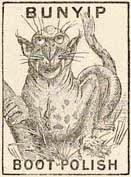A RECENT paramour, a lovely and good-hearted gal, was very keen on a night at the flix, especially if the Westgarth or Sun happened to be showing a documentary purporting to distill the essence of what you might call the Indigenous Experience. Her enthusiasm was a mystery because, if you have seen one such film, you have seen them all. Scatter a few blackfellas and a heavy dollop of white guilt about the screen, chuck in a reverential narrator, and polish the lot to a blinding gloss with a Film Australia grant and Jean-Jaques Rousseau’s old chamois. Why she took such delight in seeing black people pick their unskinned dinners from beds of embers must remain a mystery, but many people do. Give the genre’s directors a chance to punctuate 90 minutes of patronising footage with long, static shots of big, red suns going up or down, usually to an accompaniment of corroboree chanting or frolicking black children, and their genius will be proclaimed all the way from Yarraville to Northcote.
One such film was called White Fella Dreamin’, which tells the story of a white martial artist and roadie who not only befriends David Gulpilil but becomes his “brother.” The narration begins with the white man proclaiming his tribe, skin type and totem and announcing that he is a now a bona fide Aboriginal, at least to his own satisfaction. He and Gulpilil go hunting, their children splash in waterholes and their wives join the menfolk about the campfire, often to watch another of those interminable bloody sunsets.
A forgettable film, despite the awards heaped upon it, it was brought to mind by today’s news that Gulpilil is off to serve five months behind bars for breaking his wife’s arm. These things happen in some relationships, be they black or white, and the purpose of this post is not to heap additional guilt on the convicted. But what of the filmmaker and his guilt, should be let off without censure? As the documentary states, he lived amongst his adopted tribe for as long as a year at a time. Why did the brutality of the Gulpilil household end up on the cutting room floor? Surely the incident that put a bash artist behind bars was not a one-off case. In a film that claims to reveal the essence of aboriginality, one of the most striking aspects – no pun intended – is omitted. The explanation can only be a commitment to mislead.

'Surely the incident that put a bash artist behind bars was not a one-off case'. Take care old son. Getting tied up in a defamation suit can be mentally and financially exhausting, and I for one do not want to miss your daily blog.
ReplyDeleteMany years ago now, your correspondent landed up in Dar es Salaam, to teach in the university, afflicted by that sense of adventure and poor judgement common at the time among young educated Westerners. Tanzanians are a confident and peaceful lot, and I was told early on not to 'bend over blackwards', for they wanted to succeed and learn on the same terms as applied in UK universities. For the foreseeable future, an exactly opposite policy will be applied in our schools and universities.
On "Aboriginality", there is a case for some who have no trace of Aboriginal blood to claim that status. The only obvious example I can point to is the late Bobbi Sykes. She was born of an Australian woman and a black American servicemen (who did not stick around). Raised in a north Queensland town, it is easy to believe that she was shunned by the whites, and I think her story is that she was befriended by some local Aborigines, and identified with them. Quite understandable and to be respected.
Prof, I tried to work it out myself and went to the Melbourne Museum just to talk to someone about the noble traditional owners of everything there. The professional but not so traditional museum employee custodian of relics pointed to weapons on display. "These were not for hunting" - so how many died in hand to hand combat?
ReplyDeleteAll we really know is that the question is a white man's fault; and that no amount of self flagellation will purge the collective guilt of preachers of historical revisionism.
Faith or works? The question was common currency in previous "civilized societies" - words both expurgated from the collectivism now in place to purge us of the very concepts.
allah hu akbar, sweet may your multi cultic day be - in celebration of the temporal now at war with all your memories. Be it a salutation of society in terminal decline?
From the Australian 23/9/2011:
ReplyDelete"His (David Gulpilil's) relationship with Ms Ashley has brought the pair regularly to court, the actor having been issued domestic violence orders in 2007 and 2009.
He has faced court in Darwin on offences ranging from weapons charges to a series of drink-driving offences, as well as domestic violence charges."
Source: http://www.theaustralian.com.au/news/nation/aboriginal-actor-gulpilil-sentenced-to-jail-for-wife-assault/story-e6frg6nf-1226144031223
PhillipGeorge there are a couple of accounts of violent killings in Edward Currs "Recollections of Squatting in Victoria; one to avenge the apparently inexplicable death of a child and the other an adult male who fell out of a tree. Curr concludes that the deaths were due to deeply held superstitions which held that if someone died or anything but the most obvious natural causes it had to have been the work of a sorcerer from anothet tribe.
ReplyDeleteContrast the maturity and honesty of a film like "Once were Warriors"
ReplyDelete